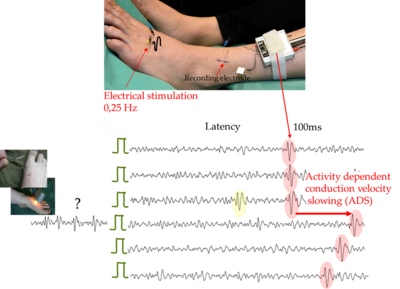The research group “Neurosciences: translational pain research” is an independent research group funded by the interdisciplinary centre for clinical research (IZKF) of the University hospital Aachen. The Institute of Neurophysiologyis the host institution for this research group from 2019 to 2024.
Our aim is to answer clinically relevant research questions in pain and itch.
We scrutinize human nociceptor/pruriceptor function and dysfunction in humans in experimental and modelling approaches in respect to the individual sensory percepts.
Microneurography
The main technical expertise of this group lies in functional single nerve fibre recordings in awake humans (microneurography). For that (see figure 1) a microelectrode is inserted into a peripheral sensory nerve and action potentials from the nearby unmyelinated (C-fibres) nerve fibres can be recorded. In parallel to the recordings the individual perception can be asked from the volunteer and correlated to the neural discharges.
This technically demanding method is used in few laboratories worldwide for the research of pain and itch. It is the only technique that can generate unique knowledge about function and dysfunction of single nerve fibres in human including pain and itch patients in real time and in correlation to the individual percept.

Supplementary to microneurography we work with in depth psychophysical routines, laser Dopper and Specle imaging and computational modelling of axonal conduction. For assessing principle properties of sensory C-fibres we work in vitro approaches with compound action potential recordings, assessing mean membrane potential changes via grease gap technique and single nerve fibre recordings in skin nerve preparation in human and animal tissue.
Our Research topics are:
Very thinn and slowly conducting nerve fibers, so called C-fibers, innervate the skin, deeper structures like muscles and inner organs and bring signals from there to the spinal cord. There the signals get processed and transmitted to the brain. Those nerve fibers are activated by stimuli which might harm the body and which might be sensed as pain or itch. We use the technique of microneurography to record signals directly from individual peripheral C-nociceptors in awake humans and correlate the signals to individual perception of stimuli that activate these nerve fibres. We are exploring which specific nerve fibers contribute to either pain or itch sensation and which patterns and magnitudes of nerve signals are leading to which sensation in which intensity.
In humans, two different C-fibre classes play completely different roles in pain and itch sensation. The mechano-sensitive nerve fibres signal spatial and temporal aspects of acute pain/itch and represent the warning of noxious stimuli acting on the body from outside and are switched off again after the warning. Mechano-insensitive nerve fibres appear to represent a long-term warning system that becomes even more active when chemical substances are involved that have already entered the body or are produced by the body itself. We are exploring the properties of these nerve fibres to gain insights that are important for understanding chronic itch and pain, their diagnosis and treatment, as these two groups of nerve fibres respond differently to damage.
Neuropathic pain is pain caused by damage to the sensory nervous system such as in diabetic polyneuropathy or so-called "small fiber neuropathy". Small-fibre neuropathy (SFN) is a condition characterised by the degeneration and dysfunction of peripheral thin, unmyelinated nerve fibres, known as Aδ- or C-fibres. Neuropathic pain affects millions of people worldwide and is associated with a significant impairment of quality of life, as no adequate therapy has yet been found.
We are studying patients with neuropathic pain due to SFN, diabetes or genetic causes of nerve pain to find out how these thin peripheral nerve fibres contribute to the symptoms of over and under function. Using the technique of microneurography we are able to detect dysfunction of thin fibres at the level of single action potentials in individual nerve fibres. We are investigating the properties of hyperactive nerve fibres in patients with neuropathic pain to identify possible targets for the treatment of persistent spontaneous neuropathic pain.
Everyone knows how distressing and unpleasant acute itching can be. When the itching sensation becomes chronic, the quality of life is significantly impaired. In addition, itching as an illness, e.g. in comparison to pain, is not very socially accepted because itching and scratching are often associated with unkemptness or parasite infestation. In Germany, about 13 percent of adults are affected by chronic itching, and effective therapies are still lacking.
We are investigating peripheral sensory nerve fibres in patients with chronic itch whose dysfunction contributes to chronic itch. These data will allow us to identify overarching cause-specific mechanisms of chronic itch and, through understanding, lead to new therapies.

![[Translate to en:] [Translate to en:]](/fileadmin/_processed_/1/8/csm__ME19193_3664692bfc.jpg)
![[Translate to en:] [Translate to en:]](/fileadmin/_processed_/0/0/csm__ME19212_eed91eb8bf.jpg)
![[Translate to en:] Mikroneurographie](/fileadmin/_processed_/0/f/csm_Microneurography_ef9bbdac84.png)